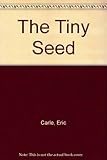Lesson 2: Structure and Meaning Cues
Lesson Plan
The Tiny Seed (Big Book) | 400L

- Learning Goal
- Use meaning cues to read unknown words.
- Use structure cues to read unknown words.
- Duration
- Approximately 50 minutes
- Necessary Materials
- Provided: Assessment
Not Provided: The Tiny Seed by Eric Carle
-
Teacher Modeling

will remind students that yesterday we learned two new strategies for identifying unknown words in a text – thinking about the meaning of the sentence and looking at the letters. Today we will learn another strategy: listening to the sentence as we say it aloud and thinking about whether it sounds right (structure cues). I will use The Tiny Seed (big book) to model how to use structure and meaning cues to decode unknown words. I will begin reading on page 16 and model substituting the word “grewed” for “grow” (structure). I will stop and think aloud about how that didn’t sound right and I will reread the sentence as I listen to establish if the sentence sounds right. I will say: "'Grewed' is not really a word and doesn’t sound right in the sentence. What word does sound right and would make sense? I think 'grow' sounds right and makes more sense." I will model this strategy again by substituting “no more” for “anymore” (structure) on page 16. I will substitute “hurray” for “hurry” (meaning) on page 16 and think aloud that that doesn’t make sense. I will continue to model these cueing systems by substituting “wanting” for “waiting” (meaning) on page 18, “children” for “child” (structure) on page 18 and “packed” for “picked” (meaning) on page 23.
TIP: Post a list of the steps students can follow to determine an unknown word using context clues: 1.Read the entire sentence that contains the unknown word. 2.Reread the sentence that came before. 3.Read the sentence after the unknown word. 4.Think about the meaning of the text.
-
Think Check
Ask: "How did I know when I did not read the correct word?" Students should respond that you read the sentence aloud and listened to how it sounded. You thought about whether the words in the sentence and the sentence itself sounded right and made sense.
-
Guided Practice

will listen for any structure and meaning errors as the teacher reads the rest of the book aloud. The teacher will substitute “growed” for “grows” (structure) on page 24, “talker” for “taller” (meaning) on page 24, “new” for “now” (meaning) on page 29, “day” for “days” (structure) on page 29, “blewed” for “blows” (structure) on page 30, “bents” for “bends” (structure) on page 30 and “sharks” for “shakes” (meaning) on page 30. We will discuss that what we read needs to make sense, look right and sound right.
-
Independent Practice

will use structure and meaning cues to decode unknown words in independent and guided reading. The teacher will assess these strategies using the attached recording form. (Assessment is provided.)
Texts & Materials
Standards Alignment
(To see all of the ReadWorks lessons aligned to your standards, click here.)


This site is wonderful! I haven't really checked it all out yet, but I love the lesson on "The Tiny Seeds"!